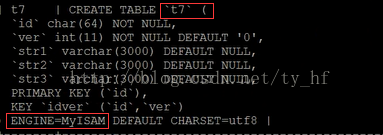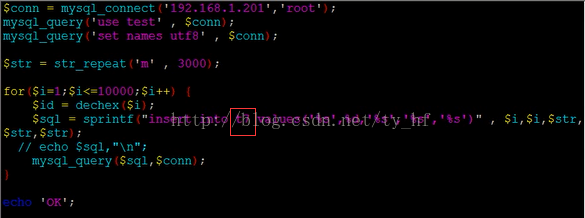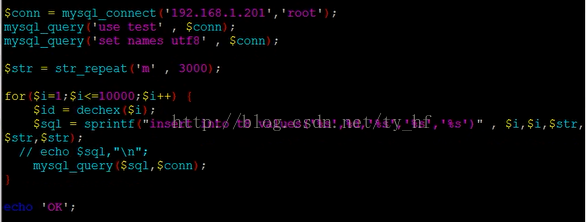Mysql-clustered index slow sorting case analysis
Why should the mysiam engine be used when executing a lot of selects? Especially when there is an index
This article relies on a practical application and analyzes it.
1. Foreword:
I saw an interesting phenomenon on the Internet. A table with 1W data volume executes different orderby conditions and query time. Very big. Is this a real problem in practical applications? ? why?

2. Analysis
a). Situation description:
1. There is primary key id, joint index (id, ver); Using the former for orderby query is slow, while using the latter for orderby query will be very fast;
2. The amount of data in each row is quite large
3.id is the main index, and the fields for select query are also If there is only an ID, then the index is covering it. You don't need to go to the physical disk to retrieve the data. You can get the data you want on the index, but the query that should be faster is slower. Mysql-index coverage
b). Analysis:
is definitely not using the mysiam engine. If so, the speed of query using these two indexes is almost the same, because What is stored in the index is the address of a physical row, and the actual amount of data occupied is not large. But it's different if it's innodb. All the data of the row is stored under its main index.
c). Conclusion:
1. Main reason: The innodb engine
used is a clustered index, and the primary key ID index also hangs the row in the dragnet. Other data, so when sorting along the ID, you have to cross many small blocks to query and traverse each ID; (there is not so much data under mysiam, it will be faster to cross the same data block and traverse more rows)
2. Reason: The amount of data in several fields is relatively large, that is, there are many people dragging their families with their families, and the amount of data is relatively large. The amount of data in each row is large, and it takes up many blocks when storing on disk
3. This problem did not exist in the mysiam engine at that time
d). Mapping conclusion:
When a lot of selects are executed, the mysiam engine should be used.
When a lot of inserts and updates are executed, the innodb engine should be used.
For more conclusions, please see: Mysql-Index Summary
3. Simulation test
Restore the conditions mentioned above, create two tables, control variables, except for the different engines, the other conditions are the same, primary key ID primary index, joint index (id, ver).
1. Create a new table t7, mysiam engine

2. Randomly insert 10,000 pieces of data

3. Execute the query statement and check the time

Obviously, the time difference is not too big , are all of the same magnitude.
4. Create a new table t8, innodb engine

5. Randomly insert 10,000 pieces of data

Interlude, when executing the statement according to the above script, the waiting time is very long. Why? Because it is a clustered index with a primary key index ID, when the primary key index is created, a large number of row data blocks are moved, and there is time for splitting and moving.
The operation is to first delete the primary key index ID, insert the data and then add primary key (id), and then create the primary key index structure

6. Execute the query statement , check the time
Obviously, the time difference is very different.
Reason: Both statements use clustered indexes, but the primary key spans too many blocks, while the joint index is a secondary index with no data underneath, few blocks, and fast traversal.

7. Overall analysis, only the t8 table (innodb) takes a long time to sort according to the primary key index, the rest are okay
Time sorting conclusion: innodb. Primary index> innodb. Secondary index> mysiam
The efficiency is nearly 27 times worse. Where is the problem?
1. The main reason is to do order by sorting along the primary key. The query will span many blocks across pages, and the time will increase
2. If there are not several long char fields, the data block will not be large. , it will not cause such a big difference.
For example, if you delete the str1, str2, str3 fields in the table, the query time will be greatly reduced, and the difference will not be obvious
The above is the content of Mysql-clustered index slow sorting case analysis. For more related content, please pay attention to the PHP Chinese website (www.php.cn)!

Hot AI Tools

Undresser.AI Undress
AI-powered app for creating realistic nude photos

AI Clothes Remover
Online AI tool for removing clothes from photos.

Undress AI Tool
Undress images for free

Clothoff.io
AI clothes remover

Video Face Swap
Swap faces in any video effortlessly with our completely free AI face swap tool!

Hot Article

Hot Tools

Notepad++7.3.1
Easy-to-use and free code editor

SublimeText3 Chinese version
Chinese version, very easy to use

Zend Studio 13.0.1
Powerful PHP integrated development environment

Dreamweaver CS6
Visual web development tools

SublimeText3 Mac version
God-level code editing software (SublimeText3)

Hot Topics
 1386
1386
 52
52
 MySQL: Simple Concepts for Easy Learning
Apr 10, 2025 am 09:29 AM
MySQL: Simple Concepts for Easy Learning
Apr 10, 2025 am 09:29 AM
MySQL is an open source relational database management system. 1) Create database and tables: Use the CREATEDATABASE and CREATETABLE commands. 2) Basic operations: INSERT, UPDATE, DELETE and SELECT. 3) Advanced operations: JOIN, subquery and transaction processing. 4) Debugging skills: Check syntax, data type and permissions. 5) Optimization suggestions: Use indexes, avoid SELECT* and use transactions.
 How to open phpmyadmin
Apr 10, 2025 pm 10:51 PM
How to open phpmyadmin
Apr 10, 2025 pm 10:51 PM
You can open phpMyAdmin through the following steps: 1. Log in to the website control panel; 2. Find and click the phpMyAdmin icon; 3. Enter MySQL credentials; 4. Click "Login".
 MySQL: An Introduction to the World's Most Popular Database
Apr 12, 2025 am 12:18 AM
MySQL: An Introduction to the World's Most Popular Database
Apr 12, 2025 am 12:18 AM
MySQL is an open source relational database management system, mainly used to store and retrieve data quickly and reliably. Its working principle includes client requests, query resolution, execution of queries and return results. Examples of usage include creating tables, inserting and querying data, and advanced features such as JOIN operations. Common errors involve SQL syntax, data types, and permissions, and optimization suggestions include the use of indexes, optimized queries, and partitioning of tables.
 How to use single threaded redis
Apr 10, 2025 pm 07:12 PM
How to use single threaded redis
Apr 10, 2025 pm 07:12 PM
Redis uses a single threaded architecture to provide high performance, simplicity, and consistency. It utilizes I/O multiplexing, event loops, non-blocking I/O, and shared memory to improve concurrency, but with limitations of concurrency limitations, single point of failure, and unsuitable for write-intensive workloads.
 Why Use MySQL? Benefits and Advantages
Apr 12, 2025 am 12:17 AM
Why Use MySQL? Benefits and Advantages
Apr 12, 2025 am 12:17 AM
MySQL is chosen for its performance, reliability, ease of use, and community support. 1.MySQL provides efficient data storage and retrieval functions, supporting multiple data types and advanced query operations. 2. Adopt client-server architecture and multiple storage engines to support transaction and query optimization. 3. Easy to use, supports a variety of operating systems and programming languages. 4. Have strong community support and provide rich resources and solutions.
 MySQL's Place: Databases and Programming
Apr 13, 2025 am 12:18 AM
MySQL's Place: Databases and Programming
Apr 13, 2025 am 12:18 AM
MySQL's position in databases and programming is very important. It is an open source relational database management system that is widely used in various application scenarios. 1) MySQL provides efficient data storage, organization and retrieval functions, supporting Web, mobile and enterprise-level systems. 2) It uses a client-server architecture, supports multiple storage engines and index optimization. 3) Basic usages include creating tables and inserting data, and advanced usages involve multi-table JOINs and complex queries. 4) Frequently asked questions such as SQL syntax errors and performance issues can be debugged through the EXPLAIN command and slow query log. 5) Performance optimization methods include rational use of indexes, optimized query and use of caches. Best practices include using transactions and PreparedStatemen
 MySQL and SQL: Essential Skills for Developers
Apr 10, 2025 am 09:30 AM
MySQL and SQL: Essential Skills for Developers
Apr 10, 2025 am 09:30 AM
MySQL and SQL are essential skills for developers. 1.MySQL is an open source relational database management system, and SQL is the standard language used to manage and operate databases. 2.MySQL supports multiple storage engines through efficient data storage and retrieval functions, and SQL completes complex data operations through simple statements. 3. Examples of usage include basic queries and advanced queries, such as filtering and sorting by condition. 4. Common errors include syntax errors and performance issues, which can be optimized by checking SQL statements and using EXPLAIN commands. 5. Performance optimization techniques include using indexes, avoiding full table scanning, optimizing JOIN operations and improving code readability.
 Monitor Redis Droplet with Redis Exporter Service
Apr 10, 2025 pm 01:36 PM
Monitor Redis Droplet with Redis Exporter Service
Apr 10, 2025 pm 01:36 PM
Effective monitoring of Redis databases is critical to maintaining optimal performance, identifying potential bottlenecks, and ensuring overall system reliability. Redis Exporter Service is a powerful utility designed to monitor Redis databases using Prometheus. This tutorial will guide you through the complete setup and configuration of Redis Exporter Service, ensuring you seamlessly build monitoring solutions. By studying this tutorial, you will achieve fully operational monitoring settings




